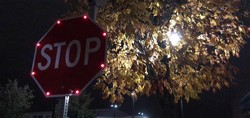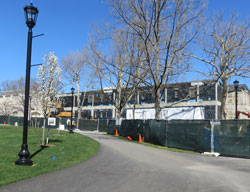Monmouth University’s operations team arranged the installation of new light up stop signs on and around campus property in the end of August.
“There is no negative aspect to light- up stop signs other than funding, so the more the merrier,” stated Cesaer Monterroso, a Criminal Justice Graduate Student from Monmouth University.
Due to excessive faculty and students breezing through stop signs on campus, Monmouth University police department decided to investigate purchasing solar stop signs.
The stop signs were placed to increase the safety of pedestrians and emphasize which roads are one way only. There were four stop signs installed with a total cost of $1,140 which was funded out of the universities operating budget.
They were added specifically at areas that are heavily used and where traffic regulations are frequently overlooked, Patricia L. Swannack, Monmouth Universities Vice President of Administrative Services said.
Not only are the solar stop signs on campus, but they are in the community surrounding campus as well. These solar stop signs are not just affecting the campus community, but the local community as well.
By implementing the solar stop signs throughout campus, the goal is to minimize the number of drivers who disregard the stop signs and roll right through them.
The new solar stop signs are all over campus however some were strategically placed at busier places on campus. “We definitely need them at certain parts on campus, for example I noticed they are at the campus entrance, and at places where there is a lot of traffic.” Olivia Santos a student stated.
According to Swannack, “One of the new stop signs was placed adjacent to the Facilities Management Building because cars often enter the one-way restricted road going the wrong way to get to Norwood Avenue.” However, it seems as though majority of the community agrees every stop sign should be a light up one.”
When asked if these stop signs should be everywhere and not just on campus Cesar Monterroso stated, “The stop signs mitigate drivers for either rolling the stop or just “blowing” the stop sign in general. Communities (if funding allows) should find solutions to upgrading each stop sign that has significant traffic either pedestrian or vehicular.”
When determining if the new light up stop signs have been successful in improving campus safety Marie Mele, a Criminal Justice Professor stated that “It’s unclear whether the new signs have improved campus safety, since their implementation has not yet been evaluated. However, when walking on campus in the evening, they are definitely more visual to the eye.”
Monmouth University takes campus safety very seriously, in fact “This campus has a number of features that make it a safe environment, including ample lighting at night, open common areas, and police patrol.” Said Mele. “These features help to prevent crime by increasing guardianship and decreasing target suitability, as suggested by Cohen and Felson’s (1979) routine activity theory.” However, Monterroso believes that Monmouth University should take serious action with regards to bigger safety issues on and around campus. As a criminal justice student, his classes have taught him about other aspects dealing with safety that the community should be worried about. For example, he believes that other circumstances like cybersecurity, emergency management and terrorism should be taken into account.
“Hacktivism, for example refers to both hacking and activism, which is an operation that uses hacking techniques against a target site with the intention of disrupting operations.” He stated. “Emergency management involves the whole community” than followed up explaining how terrorism back in the day was seen completely differently than it is today. “In my opinion, MU is not prepared to face any of these safety concerns.”
Although the new light up stops signs impact campus safety more than the prior ones, campus police officers are still patrolling and doing their job to the best of their ability. “I did see a police officer standing by the main entrance stop sign the other day for the first time in a while. He was making sure people were actually stopping. This made me feel safe, like we do matter” Olivia Santos felt.
For the future, Swannack did not specify if they planned on adding more solar stop signs. However, she did state that they have been thinking about changing a significant traffic route on the university’s campus.
The main reason in doing so is because of people’s speed. She stated, “Earlier this week the Police were monitoring traffic in front of Wilson Hall. We are considering whether or not we should eliminate driving in front of Wilson Hall during the day and/ or evening hours”.
The road in front of Wilson Hall is one of the busiest roads on campus, by eliminating this it would make it almost impossible to easily get from one side of campus, to another in a vehicle.
Swannack followed up stating, “People are driving much too fast on the interior roadways of our campus.” Swannack did not mention if this had been a problem in the past, or a frequent problem either however did directly link this issue to the solar stop signs.
They also investigated other ways to fix this problem. “We were researching various ways to slow traffic down and to be certain that people know when a roadway is one way only. In the past we had speed calming devise (basically speed bumps) but they are not supported by emergency management officials.” Swannack stated.
Moving forward, the stop signs have positively affected the traffic around campus, and continue to improve campus safety.
PHOTO TAKEN by Matthew Cutillo



